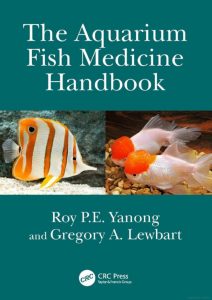The comprehensive fish care how-to-guide officially releases on April 15
By Suzette Cook
UF School of Forest, Fisheries, and Geomatics Sciences
GAINESVILLE, FL — Professors from the University of Florida and North Carolina State University have teamed up to author a thorough yet concise how-to-guide for keeping fish under human care healthy and thriving.
The Aquarium Fish Medicine Handbook officially releases on April 15 and is available for pre-order from publisher Routledge Taylor & Francis Group and Amazon.
The guide is written for practicing veterinarians, veterinary technicians, professional aquarists, fish researchers, and tropical fish hobbyists and contains 288 pages with 212 color illustrations.
“While there are many books on the market that explore the topics of ornamental fish health and care, none provide the amount of helpful information and resources in such a small, affordable package,” according to the publisher’s description.
“The book is filled with valuable and applicable information on dozens of topics including how to manage aquatic life support systems for fish, history taking, natural history, anatomy, physiology, diagnostic techniques, anesthesia, analgesia, and surgery. Virtually all of the most important ornamental fish pathogens, including viruses, bacteria, fungi, and parasites, are described and richly illustrated. There are also sections on fish welfare and conservation.”
Co-authors Roy P.E. Yanong, VMD and Gregory A. Lewbart, VMD bring a combined 68 years of veterinary and research experience to the book.

Yanong is a professor and extension veterinarian for the University of Florida’s School of Forest, Fisheries, and Geomatics Sciences (SFFGS) who co-founded the American Association of Fish Veterinarians. In addition to decades of experience with fish species, he also works with health and diseases of aquatic invertebrates and herptiles. He is based out of the UF/IFAS Tropical Aquaculture Laboratory in Ruskin, Florida, and hosts the podcast Aquariumania on Pet Life Radio.
Lewbart is a professor at North Carolina State College of Veterinary Medicine who has authored or co-authored more than 200 articles and 30 book chapters about invertebrates, fishes, amphibians, and reptiles and has made 28 trips to the Galápagos doing fieldwork on a wide variety of species.
A 2022 ornamental fish market study by Grandview Research states that about 12 percent of households globally have at least one ornamental fish. The report attributes fish ownership popularity to, “The ease of pet care and the range of colors available,” and “that these appealing, colorful, and serene fish kept as pets in small aquariums provide a variety of psychological advantages for customers of all ages, but particularly millennials. The advantages extend beyond just lowering stress after a demanding workday. It is widely acknowledged that watching decorative aquatic species float serenely through the water helps soothe and relax people.”
Fish ownership in the U.S. is ranked third after dogs and cats according to the 2022 Pet Ownership and Demographics Sourcebook published by the American Veterinary Medical Association (AVMA). The study also reveals that “People ages 25 to 54 are most likely to be pet owners and that people ages 35 to 44 have the highest rate of ownership at 75 percent.”
Yanong describes the book’s contents as starting with the basics. “First, with full-color pictures, we introduce some of the more commonly kept freshwater and marine aquarium fish, including general information on major families and groups,” he said.
“We next cover general husbandry topics that are important for keeping them alive such as aquarium systems, water quality, and nutrition. We follow these chapters with a section on general reproduction for several reasons: Many hobbyists are interested in this topic, some species of fish become more territorial or aggressive when sexually mature, some species can switch sex and change social dynamics within a group aquarium. Methods to properly sex some groups of fish are presented to help hobbyists and others interested in maintaining specific sex ratios to reduce aggression or for breeding.

Lewbart said the idea for the collaboration came from a 50-page handbook he authored in 2007 at the request of the Zoological Education Network. Teaming up with Yanong was based on their long history of meeting at the University of Pennsylvania’s veterinary school in 1988 – Lewbart as a recent graduate working as a veterinarian at a tropical fish wholesaler and Yanong as a first-year student interested in aquarium fish medicine and learning from Greg.
“We have remained close friends and colleagues now for over 35 years. When the CRC Press approached me about “resurrecting” the ZEN handbook, I knew there was only one person that needed to be involved and that was Roy,” he said.
According to Yanong, other chapters in the guide are dedicated to fish disease work ups and non-lethal, medical, and surgical approaches, as well as post-mortem approaches to disease investigation, to provide guidance for veterinarians who may not see fish as often as more seasoned clinicians.
“These chapters are also useful for non-veterinarians to understand how veterinarians approach problem solving — if they are concerned about their own fish and are interested in problem-solving on their own, but also what information veterinarians need and what they can do if helping a client.”
Other chapter titles, there are 16, include Common Medical Conditions and Euthanasia, Anesthesia, and Sedation.
With the first edition now off the presses, Yanong said curating and updating the guide to keep it current will be a priority and he looks forward to feedback.
“As handbooks and textbooks go, there are always going to be things we will learn as we get feedback on this first edition,” he said. “We look forward to hearing from those who purchase and use the book.
“We hope the conciseness and handbook style makes the book more accessible to those who are not as familiar with the aquarium hobby and fish medicine as well as those who have a lot of knowledge but don’t mind a brief refresher, with perhaps some sections introducing updated information in a clearer presentation.”
To arrange for an interview please contact the authors at Greg_Lewbart@ncsu.edu and rpy@ufl.edu
Book Cover and Author Photos: The Aquarium Fish Medicine Handbook | Flickr
 1
1
